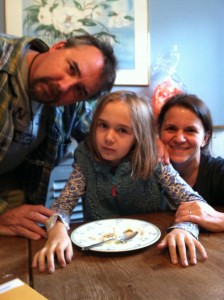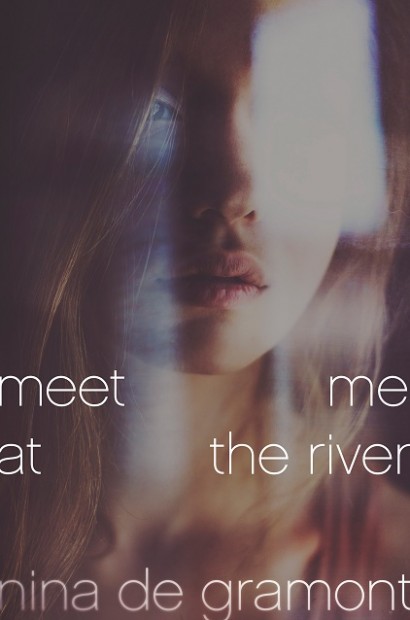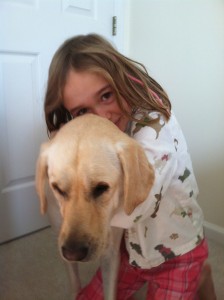Table for Two: An interview with Nina de Gramont
categories: Cocktail Hour / Table For Two: Interviews
2 comments
Bill: Where would you like to have our pretend dinner?
Nina: I wish we could have dinner at The Bombay Club in Harvard Square.
Bill: Ah, perfect! I will order the hydrabadi bagare bagain. Because it sounds like a bargain, at least in Boston talk… And I like eggplant always. So, just quick, before the waiter comes, tell us about your newest novel, Meet Me at the River.
Nina: I will need a moment to choose between the vindaloo and the saag. Also, I just found out The Bombay Club moved to the South End and then closed, which is a travesty, but since this is my imaginary dinner I can be stubborn.
Bill: We can have our imaginary dinner wherever we want! And a ghost restaurant seems appropriate, come to think of it. Though I think they may have reopened in Burlington, Mass.
 Nina: The book. It’s a ghost story and a love story. After Luke dies, Tressa is so devastated that his ghost comes back to her at night to help her work through everything that happened between them and the events that led to his death. Despite that premise, it’s a mostly realistic story about grief and healing.
Nina: The book. It’s a ghost story and a love story. After Luke dies, Tressa is so devastated that his ghost comes back to her at night to help her work through everything that happened between them and the events that led to his death. Despite that premise, it’s a mostly realistic story about grief and healing.
Bill: And these are high school kids.
Nina: Yes.
Bill: Was it hard to switch back and forth between the voices of Luke and Tressa?
Nina: Yes! I didn’t realize that it was until I gave the manuscript to my editor and she told me Luke and Tressa sounded like the same person. To fix this I had to work out their different voices over many drafts. That was definitely the most challenging aspect of writing this book. Luckily this fellow named Bill Roorbach made himself available to me, and he was a huge help.
Nina: I can get you in touch with him, if you like.
Bill: Mm. What was it like getting inside a teenage boy’s head?
Nina: It was tough, but again, luckily I had Bill Roorbach to help me. It turns out he has an excellent memory.
Bill: Or is still seventeen.
Nina: One of the hardest things was cutting lines of Luke’s that I really liked, that I felt illuminated the story, and then I realized I could give those to Tressa, since the original problem was that they sounded too similar.
Bill: Tressa struck me as an old soul, someone really open to feeling between worlds, full of wisdom and kindness, also love. How do you build a character like that? I mean where did she come from? Or did she just walk into your study one day?
Nina: In my first draft, she was a lot more focused on her own grief, and less sensitive to what was going on with others – more prone to being annoyed by them than sympathetic. She became much kinder and more aware as I rewrote, largely at the suggestion of my editor, Caitlyn Dlouhy. I am working on another novel with Caitlyn now, and the same thing is occurring – my narrator is becoming more generous, which of course speaks to Caitlyn’s nature.
Bill: Or her ability to help you get to yours! What, really, is the difference between Y.A. fiction and normal old serious literary fiction? I read this book in a somewhat earlier version and found complete enjoyment.
Nina: I think this book in particular could have been published as either, since the primary narrator, Tressa, is eighteen, and the subject matter is fairly dark. In general a YA novel is about teenage characters, told from a teenage perspective—no adults looking back. But as both a reader and a writer, I really don’t make an aesthetic distinction. One of my favorite novels of the last twenty years is Feed by M.T. Anderson, and there are many other really wonderful and very literary books for teens.
Bill: Tell us about some more we should be reading.
 Nina: Anything by John Greene. Laurie Halse Anderson. What Comes After by Steve Watkins. Some beautiful middle grade novels, too, I love The Underneath and Keeper by Kathi Appelt (her newest novel was just nominated for a National Book Award).
Nina: Anything by John Greene. Laurie Halse Anderson. What Comes After by Steve Watkins. Some beautiful middle grade novels, too, I love The Underneath and Keeper by Kathi Appelt (her newest novel was just nominated for a National Book Award).
Bill: You work in a number of genres. How do they inform one another? Is it hard to go back and forth?
Nina: It’s not hard to go back and forth because they inform one another. I learn different lessons about pacing, perspective, and voice from different projects. Every time I write a book I learn something new and defining about craft, which hopefully makes the next one better regardless of genre. And always, no matter what you’re doing, your own natural aesthetic remains. There’s nothing you can do to excise that, even if you want to. Have you watched Werner Herzog’s documentary about texting and driving? It’s really not even a documentary so much as it’s a long PSA. But all these techniques and obsessions that you see in his other films – with faces, and shadow, and repeated visual images – are present. It’s really interesting. And very powerful!
Bill: He is an amazing leaper of boundaries. Like you. Tell us about some recent projects.
Nina: I have another YA novel coming out with Atheneum next year, called The Boy I Love. And I am also working on a novel for grownups.
Bill: “The Boy I Love,” that’s a great title. Is the publicity push for a Y.A. novel similar to that of an “adult trade” book?
Nina: For a YA novel it’s mostly on-line, lots of blog coverage and Q&As, not all the readings, which is nice for me because I have terrible stage fright.
Bill: You?
Nina: Oh, yes. In college I was originally a theater major. I switched to English because I couldn’t bear the terror of performances. I loved everything about the whole process of a play right up until the performance. And then I loved the cast parties.
Bill: Tell us a stage fright story.
Nina: My first reading for my first book was at Housing Works in New York City. It’s an extremely well attended reading series, and I was standing in the back watching the room fill up and fill up. My friend Joseph – who hasn’t been off the island of Manhattan since about 1985 – was with me, and I started saying things like, “I can’t do this,” and “I really can’t do this,” and “There’s no way I can do this.” He grabbed me by the shoulders and said, “Nina. Listen. New Yorkers are lovely people and we all wish you well.” I try to cobble together a form of this sentence in my head, any time I have to do a reading.
Bill: Speaking of lovely people, what’s it like living with the Superstar co-creator (and semi-retired) chief cartoonist at Bill and Dave’s Cocktail Hour?
Nina: It is inspiring and educational. David is tirelessly creative and intellectually curious. Plus he likes to talk so I learn about whatever new topic he’s researching.
Bill: Does he read your work in progress?
Nina: Not anymore. There’s just no time.
Bill: Do the two of you have any children that love dogs or perhaps wolves?
Nina: In fact we do, Hadley the wonder girl, who loves all things canine. Do you know that this is National Wolf Appreciation Week? A great time to go the Defenders of Wildlife website and find out what you can do to help return Endangered Species Protection to gray wolves!
Bill Roorbach collects rusty objects and shells, also books.





More! This is really interesting. I was at one of Nina’s readings about three years ago. She didn’t seem nervous at all, and it was great.
For me this was a real treat! You both connect well. From reading your books, I think this is because you both have “awesome imaginations”.